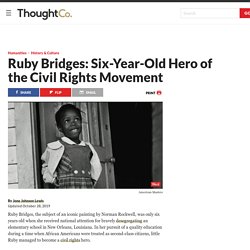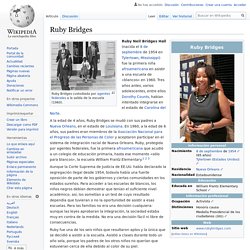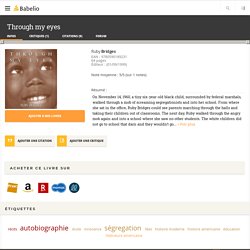Zoom
Trash

Ruby 1. (4) Ruby Bridges - Trailer. (4) Ruby Bridges - Trailer. Untitled. Freedoms's Legacy: A Conversation with Ruby Bridges Hall. Ruby Bridge’s Historic Leadership In Civil Rights At The Age Of 6. Social Studies Story Video for Children. Ruby Bridges - Facts, Quotes & Movie. Early Life Ruby Nell Bridges was born on September 8, 1954, in Tylertown, Mississippi.

She grew up on the farm her parents and grandparents sharecropped in Mississippi. When she was four years old, her parents, Abon and Lucille Bridges, moved to New Orleans, hoping for a better life in a bigger city. Her father got a job as a gas station attendant and her mother took night jobs to help support their growing family. Soon, young Bridges had two younger brothers and a younger sister. Education and Facts The fact that Bridges was born the same year that the Supreme Court handed down its Brown v.
When Bridges was in kindergarten, she was one of many African American students in New Orleans who were chosen to take a test determining whether or not she could attend a white school. Ruby Bridges: Six-Year-Old Civil Rights Hero. Ruby Bridges, the subject of an iconic painting by Norman Rockwell, was only six years old when she received national attention for bravely desegregating an elementary school in New Orleans, Louisiana.

In her pursuit of a quality education during a time when African Americans were treated as second-class citizens, little Ruby managed to become a civil rights hero. First Years Ruby Nell Bridges was born on September 8, 1954, in a cabin in Tylertown, Mississippi. Her mother, Lucille Bridges, was the daughter of sharecroppers and had little education because she worked in the fields. Lucille sharecropped with her husband, Abon Bridges, and father-in-law until the family moved to New Orleans.
School Desegregation In 1954, just four months before Ruby was born, the Supreme Court ruled that legally-mandated segregation in public schools violated the Fourteenth Amendment, making it unconstitutional. Integrating William Frantz Elementary The Toll of Ruby's Efforts Adult Years. The Problem We All Live With. 1964 painting by Norman Rockwell The Problem We All Live With is a 1964 painting by Norman Rockwell.

It is considered an iconic image of the Civil Rights Movement in the United States.[2] It depicts Ruby Bridges, a six-year-old African American girl, on her way to William Frantz Elementary School, an all-white public school, on November 14, 1960, during the New Orleans school desegregation crisis. Because of threats of violence against her, she is escorted by four deputy U.S. marshals; the painting is framed such that the marshals' heads are cropped at the shoulders.[3][4] On the wall behind her is written the racial slur "nigger" and the letters "KKK"; a smashed and splattered tomato thrown against the wall is also visible. The white protesters are not visible, as the viewer is looking at the scene from their point of view.[3] The painting is oil on canvas and measures 36 inches (91 cm) high by 58 inches (150 cm) wide.[5] History[edit] The painting was used to "dress" O.
See also[edit] Ruby Bridges. Ruby Nell Bridges Hall (nacida el 8 de septiembre de 1954 en Tylertown, Mississippi) fue la primera niña afroamericana en asistir a una escuela de «blancos» en 1960.

Tres años antes, varios adolescentes, entre ellos Dorothy Counts, habían intentado integrarse en el estado de Carolina del Norte. A la edad de 4 años, Ruby Bridges se mudó con sus padres a Nueva Orleans, en el estado de Louisiana. En 1960, a la edad de 6 años, sus padres eran miembros de la Asociación Nacional para el Progreso de las Personas de Color y aceptaron participar en el sistema de integración racial de Nueva Orleans. Ruby, protegida por agentes federales, fue la primera afroamericana que acudió a un colegio de educación primaria, hasta ese momento «sólo para blancos», la escuela William Frantz Elementary.[1][2][3] Ruby fue una de los seis niños que resultaron aptos y la única que se decidió a asistir a la escuela. William Frantz Elementary School en 2010. Through my eyes - Ruby Bridges. Ruby Bridges a 6 ans lorsqu'en 1960, des membres de la NAACP l'aide (elle et ses parents) à intégrer une école de la Nouvelle-Orléans, qui avait jusque là refusé d'inscrire des enfants noirs.

Et cela, en dépit du fait que la ségrégation à l'école avait été déclarée anticonstitutionnelle 6 ans plus tôt par la Cour Suprême. Rien ne destinait cette petite fille de 6ans a devenir un symbole pour les Etats-Unis et surtout pour la communauté afro-américaine. Et pourtant… Il faut croire qu'en plus de sa mère, les fées du Courage et de la Détermination s'étaient penchées sur son berceau. J'ai trouvé cette autobiographie très touchante. Ecrite de façon très simple, mais franche et avec beaucoup d'émotions et d'affirmation de sa foi en Dieu et en son Destin comme les Américains savent le faire.
The Story of Ruby Bridges.